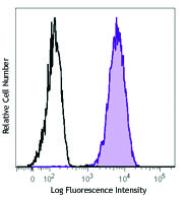-
Sign In
-

-
 Sony Biotechnology
Sony Biotechnology
-

-
 Sony Biotechnology
Sony Biotechnology
Brilliant Violet 421™ anti-human CD13
Antibodies Single
Sony
WM15
Flow Cytometry
Mouse IgG1, κ
Human
2108575
$191.00
Description
CD13 is a 150-170 kD type II transmembrane glycoprotein also known as aminopeptidase N, APN, and gp150. This zinc metallopeptidase is expressed as a homodimer on granulocytes, myeloid progenitors, endothelial cells, epithelial cells and subset of granular lymphoid cells. It is not expressed on platelets or erythrocytes. CD13 is thought to be involved in the metabolism of many regulatory peptides and functions in antigen processing and the cleavage of chemokines such as MIP-1. CD13 serves as the cellular receptor for Coronavirus.
Formulation
Phosphate-buffered solution, pH 7.2, containing 0.09% sodium azide and BSA (origin USA).Recommended Usage
Each lot of this antibody is quality control tested by immunofluorescent staining with flow cytometric analysis. For flow cytometric staining, the suggested use of this reagent is ≤5 microL per million cells or 5 microL per 100 microL of whole blood. It is recommended that the reagent be titrated for optimal performance for each application.
Brilliant Violet 421™ excites at 405 nm and emits at 421 nm. The standard bandpass filter 450/50 nm is recommended for detection. Brilliant Violet 421™ is a trademark of Sirigen Group Ltd.
This product is subject to proprietary rights of Sirigen Inc. and is made and sold under license from Sirigen Inc. The purchase of this product conveys to the buyer a non-transferable right to use the purchased product for research purposes only. This product may not be resold or incorporated in any manner into another product for resale. Any use for therapeutics or diagnostics is strictly prohibited. This product is covered by U.S. Patent(s), pending patent applications and foreign equivalents.
References
1. Knapp W, et al. 1989. Leucocyte Typing IV. Oxford University Press. New York.
2. Saiki I, et al. 1993. Int J Cancer. 54:137. (Block)
3. Rosenzwajg M, et al. 2000. Blood 95:453. (Block)
4. Kawase M, et al. 2008. J Virol. 83:712. (Block) PubMed
5. Di Matteo P, et al. 2011. J. Histochem. Cytochem. 59:47. (IHC)


